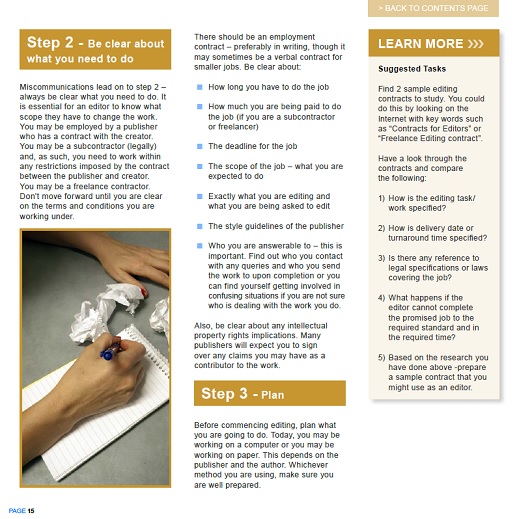Learn the Fundamentals of Editing
for: Articles, Newsletters, Web sites, Blogs, Reports, Submissions, Resumes, Student Assignments, Letters, Books, or anything else.
- What You Write Matters
- When You can Edit Faster and Better: Your Writing is Better
- When You Write Better You Succeed More
It is said that the sign of a good editor is one whose
work goes unnoticed - however those who reach this level of expertise are very
much noticed by others. Anyone with superlative editing skills is sought
after.
Do you wish to develop your skills in this area? Your editing efforts can bring greater meaning and clarity to a work, ensuring the author's voice is heard and the message is clear. Editing is much more than reading and spell-checking however. It is a specialised area of
writing which involves liaising with writers and publishers to ensure
all sorts of documents are as good as they can be before they are
published.
Editing is a process which involves a number of steps from securing
the work, checking manuscripts and contents, copy or subediting, and
ultimately proofreading. The complexity of what is involved varies with
the type of work, the length of manuscript and the duration or
time-frame allocated.
When it comes to editing, we all have a lot to learn - we all have improvements to make.
Whether your write for business or pleasure, on-line or on paper, this course offers you a flexible and accessible way to enhance your editing skills and understanding.
What is covered in this course?
HOW TO WORK THROUGH THIS COURSE
LESSON 1 HOW MUCH EDITING?
Introduction
Finding a Balance and Setting Priorities
Why Are You Editing?
Fiction and Non-Fiction
Editing Fiction
Editing Non-fiction
Personality Traits of Editors
What do you need to be a good editor?
Dysfunctional Editors
Functional Editors
Editing Traps
Review what you have been learning
LESSON 2 STAGES OF EDITING
Introduction
Editing Steps
Step 1 - Securing the Document
Step 2 - Be clear about what you need to do
Step 3 - Plan
Step 4 - General Editing
Step 5 - Copy Editing
Step 6 - Illustrations
Step 7 - Styling
Example of a Simple Style Guide
Step 8 - Proofreading
Step-By-Step
Review what you have been learning
LESSON 3 TYPES OF EDITING
What Are Your Editing Criteria?
Improving Content
Aim for Originality
Maintain Interest
Keep it Current
Make Sure It’s Complete
Improving Readability
Clarity
Accuracy
Tone and Style
Impact
Grammar
Spelling
Consistency
Spelling and Grammar isn’t Constant!
Editing a newsletter
Editing a blog
Editing a print magazine or newspaper
Editing a sales catalogue
Editing a brochure
Editing a fiction book
Editing a non fiction text book
Editing research papers and journal articles
Conclusion
Review what you have been learning
LESSON 4 TOOLS AND LANGUAGE
Editing and Proofreading Symbols
Examples of Proofreading Symbols
Proofreading Tips
IT Tools
Spellcheckers
Autocorrect
Find and Replace
Track Changes
Editing Images
Plagiarism
Review what you have been learning
LESSON 5 INTERPERSONAL SKILLS FOR EDITORS
Communication
Listening and Talking
Written Communication
Advanced Written Communication
Structure
Style
Content
How Editors Communicate
When and Where Editors Work
Review what you have been learning
LESSON 6 FINDING WORK AND SELLING YOURSELF
Editing Today
How to Sell Yourself
Freelancing
Setting Up Your Own Website
Resources
Final Thoughts
Review what you have been learning
Final Assessment
FINAL ASSESSMENT
Features:
SAMPLE PAGES FROM THE COURSE
